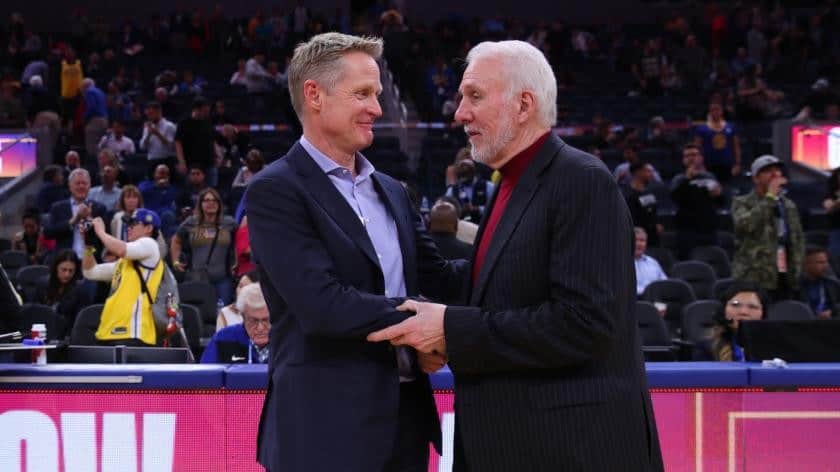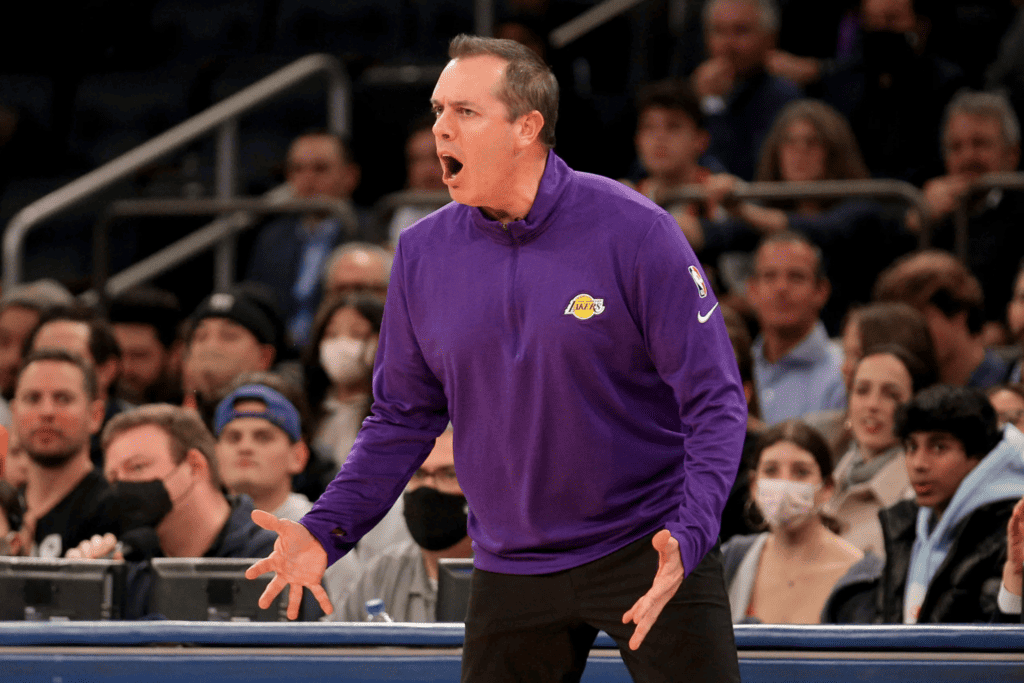Most NBA coaches get fired for not meeting expectations, especially in terms of winning games. While that is the most common reason, coaches can get fired for a combination of reasons or a different reason altogether. Other reasons that can get coaches fired include violating the terms of a contract, having rifts with the front office and/or players, or being replaced due to a regime change, among other reasons.

Greg Popovich & Steve Kerr have won 9 Coaching titles between them. They will not get fired.
What is the average tenure of an NBA coach?
A report in 2018 looked at the average tenure of coaches in the last 20 years across the 4 major North American leagues: the NBA, the NHL, the MLB, and the NFL. The average tenure of an NBA coach in that period was 2.4 seasons, the shortest of the 4 major professional leagues, meaning that coaching changes are the most frequent in the NBA. Another figure from the same study noted that 24 coaches have coached 3 or more different teams in that period of time, more than any other league; this means that coaches often find another head coaching job within the NBA.
Who is the longest-tenured active NBA coach?
The longest-tenured active coach in the NBA is Gregg Popovich, who has been the head coach of the San Antonio Spurs for 26 years and counting. In fact, he is the longest-tenured active coach in any of the 4 major North American leagues (NBA, MLB, NFL, and NHL). Popovich is one of the most successful coaches in NBA history, credited with building a dynasty with the Spurs that won 5 championships under him. He also holds the best regular-season win percentage in NBA history, a big reason for why the Spurs have kept him this long.
How much do NBA coaches get paid?
Reported figures place the average salary of an NBA coach at around $4 million a year. There are several coaches who make between $8 million and $11 million a year; these are usually coaches who are long-tenured (and have met or exceeded expectations for a sustained period of time) and/or coaches who have a high pedigree of success in the league. There are no salary cap implications for coaches, so salaries can be freely negotiated by a coach’s agent and the organization.
What happens to an NBA coach’s contract if they get fired?
NBA coaches’ contracts are often guaranteed, so if they do get fired, they are still entitled to the remaining salary on their contract. Coaches may not be entitled to the remaining salary if the contract is unguaranteed (very rare) or if they have violated the terms of their contract or criminal conduct (an extreme scenario, also very rare).

Why do coaches often lose their jobs rather than players?
You will often see a coach get fired before there is any major roster shakeup. But why is that? Shouldn’t players, who are the ones who are actually on the court, bear responsibility for a losing record? Simply put, it’s anything but simple.
Coaches are like managers of the team, and usually management has to bear accountability for a team’s performances (rewarded when successful, and termination when unsuccessful). But it goes beyond that. It is cheaper for a team to fire a coach than to “fire” it’s players (released or waived), and that’s because of the numbers.
The average salary of an NBA coach is $4 million, with the best-paid coaches being paid $8-$11 million. The average salary of an NBA player is double that (around $8 million a year), with the highest-paid players taking home between $40-$50 million a year. With most NBA contracts being guaranteed, waiving a player is much more expensive than firing a coach just based on averages; waiving more than 1 player is even more costly.
Organizations can often take the hit where necessary, but there’s also salary cap implications. Waiving a player means that while the team still has to pay that salary, it also counts against the salary cap. If the salary is still counted in the salary cap, that means that teams may not have enough cap space to sign a replacement. To waive more than one player on big salaries would be catastrophic on a team’s salary cap. Coaches are not included in the salary cap, so teams can sign a new coach as their finances allow.
What do teams do with players who they don’t want anymore? Well, they have several options: they can waive them and hope another team picks up their contract. They can also trade them to another team for assets in return: players, draft picks, and/or cash. They can also let their contracts run out, making those players free agents.
To summarize, there are more flexible and cost-friendly options to deal with underperforming players compared to underperforming coaches, where one of the only options is termination. Sometimes the reason for an underperforming player is the coach themself; a change in coaching can often bring out the best in a group of players. Owners and general managers often hold this belief when they decide that a change is needed.
Being a coach in the NBA means that results need to come immediately and expectations need to be met. Moreso, coaches have to navigate organizational politics as well if they want to survive. If there are a few bright spots in what looks like a job with a permanent hot seat, is that coaches will get their money and will also likely find another head coaching job on another NBA team in due time.
